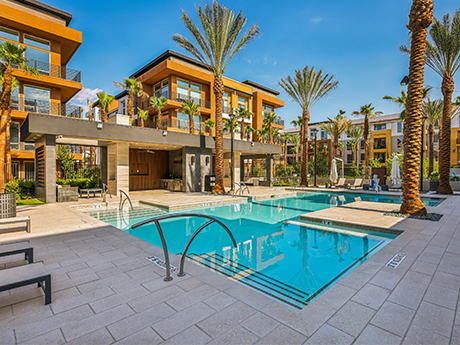— By Adam Schmitt of CBRE —
The Las Vegas multifamily market is experiencing a significant transformation that’s shaped by new construction trends and evolving market dynamics. As the city continues to expand and adapt, it is essential for current investors, developers and capital allocators to understand the opportunities and barriers for growth.

The multifamily market has seen substantial fluctuations since the onset of COVID-19. Rents surged by 24.6 percent in 2021, buoyed by government interventions. However, as these supports diminished, vacancy rates rose sharply, climbing from an average of 3.4 percent in 2021 to 7.35 percent in 2023. Recent trends, however, indicate a recovery. Vacancy rates have decreased to 6.5 percent as of February, which hint that multifamily fundamentals may be regaining stability and moving toward normalized averages.
The single-family housing market is another critical element influencing the overall health of Las Vegas’ economy. The market produced 160,092 single-family homes between 2003 and 2008. However, only 142,455 were built between 2009 and 2024. This slowdown has led to soaring home prices, even amid rising mortgage rates approaching 7 percent. Consequently, the growing disparity between renting and owning has created favorable conditions for rental housing demand, further solidifying the multifamily market’s role in the broader economic landscape.
In 2023, the market saw the introduction of about 7,000 new apartment units, elevating the total inventory to around 220,000 units. That figure is about double the long-term average of 3,500 units per year, translating to a new supply ratio of just 3 percent. This is considerably lower than the 9 percent to 12 percent delivery ratios seen in other Sunbelt markets. The disparity underscores how severely under-supplied Las Vegas has been in terms of multifamily housing, fueling the current push for new developments.
The predominant focus of new developments has been on suburban garden-style projects, which appeal to a wide range of renters. High-end developments like Vestra, Evora and Ilumina at Raiders Way are raising the bar for Class A multifamily housing, attracting a demographic that seeks modern amenities and upscale living environments. The emergence of single-family rent and build-to-rent projects is also indicative of a growing demand for larger living spaces that provide the benefits of single-family homes without the long-term commitment or exponentially higher cost of purchasing a home.
Development activity is primarily concentrated in specific Las Vegas submarkets. The southwest region has the most under construction with 9,106 new units in the 2024 to 2026 pipeline. The West Henderson/South Las Vegas area follows with 3,884 units. Despite having a smaller
overall pipeline of 2,994 units, North Las Vegas actually boasts the highest new supply-to-inventory ratio at nearly 20 percent. This suggests that while some areas face increased competition, the overall market remains relatively balanced, providing opportunities for both developers and renters.
The Las Vegas MSA has moved past its peak supply as of second-quarter 2024, but the market is still working to stabilize its record supply. Concessions, such as six to eight weeks of free rent, are prevalent in high-supply areas like the Southwest, West Henderson and North Las Vegas.
Several established developers, including Picerne, NV West, Ovation, the Wolff Company and the Calida Group, continue to dominate the Las Vegas multifamily landscape. New entrants like MorganStonehill, Greystar, NRP and Southern Land Company are diversifying the market, enhancing competition and improving the quality of available housing. This variation of developers is vital in meeting the evolving needs of a diverse population.
Unfortunately, the unique landownership situation in Southern Nevada presents both challenges and opportunities. About 86 percent of all land in and around the Las Vegas Valley is federally owned, creating a significant barrier to entry for new developments. An estimated seven-year “run” on the remaining privately owned land parcels further complicates the landscape. It potentially limits future multifamily supply while increasing competition among investors in the Valley. This constraint could influence development timelines and strategies, as well as overall market dynamics.
Institutional investment in the Las Vegas multifamily market is also on the rise. Both Fairfield and Brookfield acquired sizeable portfolios in 2024. This underscores the market’s maturation into an institutional-grade environment. High-quality ownership and management practices are expected to further enhance the overall market landscape.
In addition to these trends, Las Vegas’ job market is experiencing substantial growth. Three major job creators opened in the third quarter of 2023, including the Sphere, Fontainebleau and Durango Resort. Combined, they added more than 11,000 new jobs. This momentum is set to continue as the Valley shifts its focus to 2027 and 2028 for its next wave of large-scale projects that are expected to add another 25,000 diversified employment opportunities. Notable upcoming projects include the Las Vegas A’s Ballpark, Summerlin Movie Studio, Hard Rock Resort, Intermountain Health’s Children’s Hospital and the Brightline West Train System, among others. The influx of jobs is likely to drive demand for multifamily housing as more residents relocate to the area for employment.
Las Vegas stands at a pivotal moment in its multifamily housing landscape. The city continues to attract attention with its balanced supply ratio, rising institutional investment and signs of a post-pandemic recovery. Add a strong job market and evolving demographics, and Las Vegas is well-positioned for sustained multifamily growth and development.
— By Adam Schmitt, First Vice President, CBRE. This article was originally published in the May 2025 issue of Western Real Estate Business.


